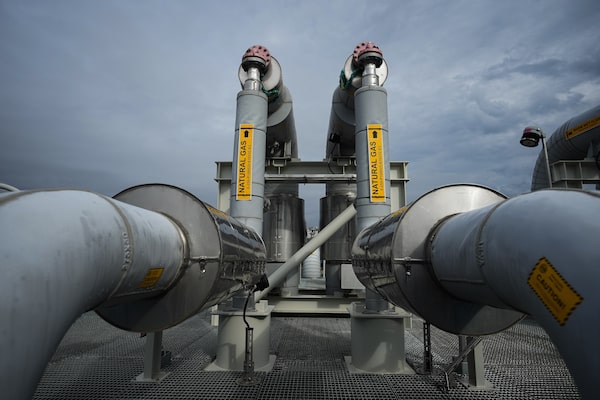
Piping on the top of a receiving platform which will be connected to the Coastal GasLink natural gas pipeline terminus at the LNG Canada export terminal in Kitimat, B.C., on Sept. 28, 2022. B.C. expects its existing surplus of power will evaporate sooner than expected after the approval of another LNG facility last month.DARRYL DYCK/The Canadian Press
British Columbia’s publicly owned electric utility expects its existing surplus of power will evaporate sooner than expected, after the provincial government approved another liquefied natural gas facility last month.
The province hopes to secure billions of dollars of investments in LNG and hydrogen production facilities, while at the same time reducing greenhouse gas emissions. To do both, it needs to ramp up its supply and distribution of electric power.
“There are indications of increased load and decreased supply from existing and committed resources, resulting in an earlier need for future resources,” BC Hydro’s chief regulatory officer, Chris Sandve, wrote in a March 23 letter to the B.C. Utilities Commission.
A week earlier, the provincial government approved the proposed Cedar LNG project, alongside a new energy action framework that calls for electrification of major new resource projects. With that added demand, BC Hydro predicts that its current plans “are insufficient to meet the future needs of our customers, and that additional near-term actions are required.”
The B.C. government’s new energy policy states that new LNG proposals need a credible plan to be net zero for emissions by 2030. The process of turning natural gas to liquid is energy-intensive, and usually is powered by burning natural gas.
The only LNG facility under construction in the province is using natural gas for most of its power requirements for the first phase of the project. LNG Canada has said it also intends to use natural gas to launch Phase 2 as well, because BC Hydro has not provided the transmission infrastructure to Kitimat, to allow for electrification of the process.
BC Hydro is building the $16-billion Site C dam to address increasing demand in general. When it comes online in 2025, Site C will provide 1,100 megawatts of energy. But Phase 2 of LNG Canada, if it were to use electricity for its operations, would require about 90 per cent of that capacity.
The province has promised to cap greenhouse gas emissions for the oil and gas sector. That will require a large-scale switch to electric power all along the production chain – at a time when British Columbia is also planning to electrify everything from commercial transportation to home heating.
Jan Gorski, of the clean-energy think tank Pembina Institute, said B.C. has a lot of work to do to ensure that it can provide enough clean energy to meet its legislated greenhouse gas reduction targets for 2030. It will have to set priorities. “They need to figure out how much capacity can be built – and what it should be used for. There’s a lot of competing demands not just for LNG but for decarbonizing transport and buildings.”
According to his preliminary analysis, Mr. Gorski said B.C. would need the equivalent of 2½ additional Site C dams for even a modest development of LNG, if it is to stay within the constraints of emissions targets for the oil and gas sector.
Josie Osborne, B.C. Minister of Energy, Mines and Low Carbon Innovation, said the energy demand isn’t clear yet, as many of the major projects on the books have not yet received a final investment decision. In the meantime, BC Hydro is setting up a task force to determine how it can meet the government’s latest clean-energy objectives.
“We have the time right now to be doing the planning that we need to. And that’s exactly what we’re doing,” she said in an interview.
But BC Hydro is under pressure from Premier David Eby to speed up its timelines. The Crown corporation says it requires up to a decade to plan and build new transmission lines, and there is no other project on the scale of Site C in the works.
The BC Utilities Commission was set to conduct hearings this year on BC Hydro’s most recent Integrated Resource Plan, which is a 20-year planning document.
While that plan is now likely to be amended, the March 28 federal budget now offers some potential relief, proposing a 15-per-cent refundable tax credit for eligible investments in clean electricity including wind, solar, hydro, wave, tidal, nuclear, energy storage and electricity transmission.